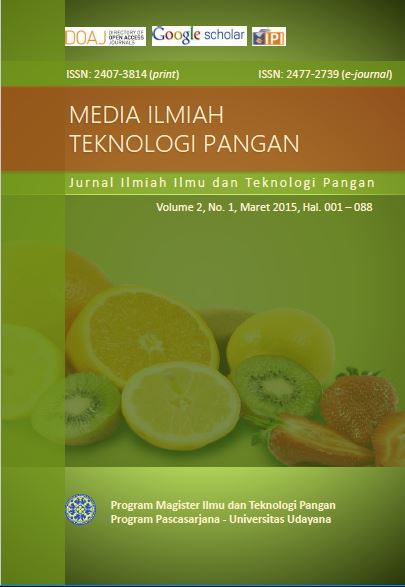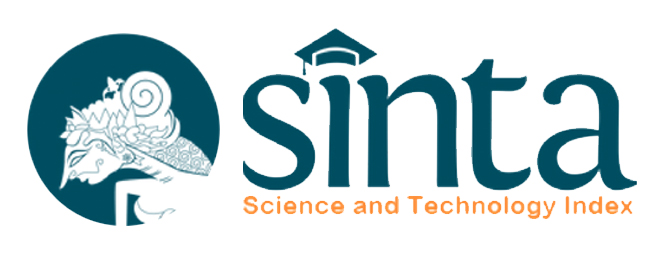Studi Konsentrasi Amiloglukosidase dan Saccharomyces cereviseae dalam Produksi Bioetanol dari Ubi Jalar Melalui Sakarifikasi Fermentasi Simultan
Abstract
The purpose of this study is to obtain the enzyme concentration and Sacharomyces cereviceae amyloglukosidase best to process simultaneous saccharification fermentation (SFS) in the production of bio ethanol from sweet potato hydrolyzated. This study was designed using a factorial randomized block design. The first factor is the concentration of enzyme amiloglukosidase consisting of 3 levels ie 0.8; 1.0 and 1.2 ml / kg substrate. The second factor is the concentration of S. cereviceae consisting of 3 levels ie 5; 10 and 15% (v / v). Variable measured include of ethanol concentration, yield, efficiency of substrates using, fermentation efficiency and concentration of substrate consumption. Data were analyzed diversity and Duncan's multiple comparison test was done to determine the best treatment.
The results showed that the concentration of the enzyme amyloglukosidase 1.2 ml / kg of substrate (3000 U / ml) at a concentration of S. cereviceae 10% (v / v) is the best treatment with the resulting ethanol concentration 7.48% (v / v), yield 19.89%, the efficiency of product formation by substrate 47.37%, 92.88% fermentation efficiency, and the concentration of substrate consumption of 15.78 g / L.
Downloads
References
Arnata I W. 2009. Alternatif Pengembangan Teknologi Bioproses Pembuatan Bioetanol Dari Ubi Kayu Menggunakan Kultur Campuran Trichoderma viride Aspergillus nigr Dan Saccharomyces cerevisiae. Tesis. Institut Pertanian Bogor.
Azmi A S, Gek C N, Maizirwan M, Masitah H. 2010. Ragi Tapai And Saccharomyces cerevisiae As Potential Coculture In Viscous Fermentation Medium For Ethanol Production. J.Biotechnology 9(42):7122-7127.
Budiyanto A, Martosuyono P, Richana N. 2005. Optimasi Proses Produksi Tepung Kasava Dari Pati Ubi Kayu Skala Laboratorium. Buletin Balai Besar Pascapanen, 1-16.
Duryatmo S, Helmina A, Wigunan I, Marlianni L, Artdiyasa N. 2007. Soekani Sukses Mengembangkan Bioetanol di Sukabumi. Majalah Trubus. www.trubus.com. Di-akses 11 Juni 2014.
Hambali E, Mudjadlipah S, Tambunan AH, Pattiwiri AW, Hendroko R. 2007. Teknologi Bioenergi. Agromedia Pustaka, Jakarta.
Hartoyo, T., 2007. The Sweet Potato Product. http: //homecooking. about. com/ library / weekly /the sweet_potato_product.html. Di-access 20 Januari 2010
Koesnandar. 2001. Biokonversi Selobiosa Langsung Menjadi Etanol Menggunakan Ko-Imobilisasi Sel Lipomyces starkeyi dan Saccharomyces cerevisiae Secara Fed-Batch. J Mikrobiologi Indonesia (6) 1: 15-18
Lezinou, V., Christapoulos, P., Kekos, D. dan Macris, B. J. 1994. Biotechnol. Di dalam : Gunasekaran, P. Dan K. Chandra Raj. Ethanol Fermentation Technology-Zymomonas mobilis. Departement of Microbial Technology, School of Biological Sciences, Mandurai Kamaraj University, India.
Musaddad A. 2005. Teknologi Produksi Kacang-Kacangan Dan Umbi-Umbian. Malang, Balai Penelitian Tanaman Kacang-Kacangan Dan Umbi-Umbian.
Nurdyastuti I. 2005. Teknologi Proses Produksi Bio-Ethanol. Prospek Pengembangan Bio-Fuel Sebagai Subsitusi Bahan Bakar Minyak.
Poosaran, et al. (1985) Rodmui A, Jirasak K, Yuwapin D. 2008. Optimization of Agitation Conditions for Maximum Ethanol Production by Coculture. Kasetsart J. (Nat. Sci.) 42 : 285 – 293
Rudolf A, malek A, Guido Z, Gunnar L. 2005. A Comparisson Between Batch And Fed Bacth Simultaneous Saccharification And Fermentation Of Steam Pretreated Spruce. J. Enzyme and Microbial Technology 37 : 195-204.
Wargiono J, A. Hasanuddin, Suyamto. 2006. Teknologi Produksi Ubi kayu Mendukung Industri Bioethanol. Badan Penelitian dan Pengembangan Pertanian, Jakarta.
Wahyuni A. 2008. Rekayasa Bioproses Pembuatan Bioetanol Dari Sirup Glukosa Ubi Jalar Dengan Menggunakan Saccharomyces cerevisiae. Pascasarjana IPB, Bogor.
Whitaker JR. 1996. Principles of Enzymology for Food Sciences. MD Inc. New York.
Wright JD, Wyman CE, Grohmann K. 1988. Simultaneous Saccharification and Fermentation of Lignocellulose. Appl Biochem Biotechnol 18: 75-90.








